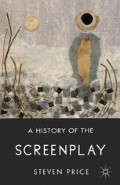Abstract
If the numbered continuity had become standardised within the Hollywood of the 1920s, the hasty conversion to sound had resulted in an ad hoc approach to resolving the technical questions confronting the script at a time of rapid industrial change. There is little consistency, at this transitional time, between scripts or often within the same script, regarding such matters as how to present dialogue, where to position the speakers’ names and how, in particular, to overcome the problem that, with intertitles having become obsolete, precisely rendered speech and action now occurred simultaneously. As Staiger remarks, ‘[e]ach studio adapted the old script format differently’.1 This prompted suggestions that the Hollywood studios should collectively introduce an agreed, standard format for the presentation of scripts.
Access this chapter
Tax calculation will be finalised at checkout
Purchases are for personal use only
Preview
Unable to display preview. Download preview PDF.
Notes
Janet Staiger, ‘The Hollywood Mode of Production, 1930–60’, in David Bordwell, Janet Staiger, and Kristin Thompson (eds), The Classical Hollywood Cinema: Film Style and Mode of Production to 1960 (London: Routledge, 1985), p. 322.
Janet Staiger, ‘Blueprints for Feature Films: Hollywood’s Continuity Scripts’, in Tino Balio (ed.), The American Film Industry, rev. ed. (Madison: University of Wisconsin Press, 1985).
Claudia Sternberg, Written for the Screen: The American Motion-Picture Screenplay as Text (Tübingen: Stauffenburg, 1997), p. 209.
Ibid., p. 75.
See, for example, Tom Stempel, FrameWork: A History of Screenwriting in the American Film, 2nd ed. (New York: Continuum, 1991), pp. 63–69.
Juárez, ed. Paul J. Vanderwood (Madison: University of Wisconsin Press, 1983), pp. 83–84.
Thomas Schatz, The Genius of the System: Hollywood Filmmaking in the Studio Era (New York: Pantheon, 1989), p. 5.
Ibid., pp. 7–8.
Petr Szczepanik, ‘Micropolitics of Screenplay Development: A Political History’, conference paper, Screenwriting in a Global & Digital World, Madison, Wisconsin, 21 August 2013.
Rudy Behlmer, Memo from Darryl F. Zanuck: The Golden Years at Twentieth Century-Fox (New York: Grove, 1993), pp. 173–74; James Curtis, Between Flops: A Biography of Preston Sturges (New York: Harcourt, Brace, 1982), p. 173. Both cited in an email from David Bordwell to the author, 21 August 2013.
Samson Raphaelson, Three Screen Comedies by Samson Raphaelson: Trouble in Paradise, the Shop Around the Corner, Heaven Can Wait (Madison: University of Wisconsin Press, 1983).
John Howard Lawson, Theory and Technique of Playwriting and Screenwriting (New York: G.P. Putnam’s, 1949), p. 370.
Robert L. Carringer, The Making of Citizen Kane, rev. ed. (Berkeley: University of California Press, 1996), p. 26.
The Citizen Kane Book (London: Secker & Warburg, 1971), p. 91.
Jeff Rush and Cynthia Baughman, ‘Language as Narrative Voice: The Poetics of the Highly Inflected Screenplay’, Journal of Film and Video 49.3 (1997), pp. 28–37
Author information
Authors and Affiliations
Copyright information
© 2013 Steven Price
About this chapter
Cite this chapter
Price, S. (2013). The Hollywood Sound Screenplay to 1948. In: A History of the Screenplay. Palgrave Macmillan, London. https://doi.org/10.1057/9781137315700_8
Download citation
DOI: https://doi.org/10.1057/9781137315700_8
Publisher Name: Palgrave Macmillan, London
Print ISBN: 978-0-230-29181-2
Online ISBN: 978-1-137-31570-0
eBook Packages: Palgrave Media & Culture CollectionLiterature, Cultural and Media Studies (R0)

